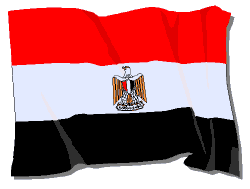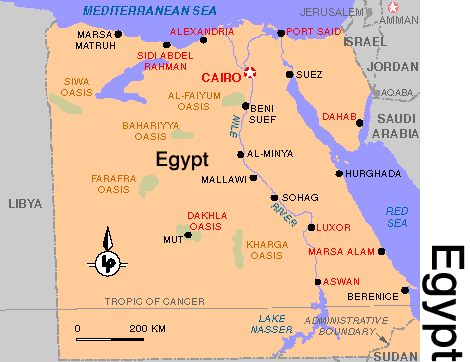- Pre-dynastic
history
Archaeological evidence suggests that hunters
inhabited Egypt over 250,000 years ago when the
region was green grassland. The Paleolithic
period around 25,000BC brought climatic changes,
which turned Egypt into a desert. The inhabitants
survived by hunting and fishing and through a
primitive form of cultivation.
-
- Desertification of
Egypt was halted by rains, which allowed
communities of cultivators to settle in Middle
Egypt and the Nile Delta. These farmers grew
wheat, flax and wove linen fabrics in addition to
tending flocks.
-
- The first indigenous
civilizations in Egypt have been identified in
the south of the country through archaeological
excavations. The Badarian culture is the earliest
known developed Egyptian civilization based on
farming, hunting and mining. Badarians produced
fine pottery and carved objects as well as
acquiring turquoise and wood through trading.
|
- The Early
Dynastic or Archaic Period (3100-2686BC)
This period is shrouded in mythology. Little is
known of Menes and his descendants outside of
their divine ancestry and that they developed a
complex social system, patronized the arts and
constructed temples and many public buildings.
- The foundation of
Memphis, the world's first imperial city, is
attributed to Menes. From Memphis the third and
fifth kings of the First Dynasty, which extended
from 3100 to 2890BC set out to conquer the Sinai.
During the First Dynasty culture became
increasingly refined. The royal burial grounds at
Saqqara and Abydos became sites of highly
developed mastabas.
- The Second Dynasty
lasting from 2980 to 2686BC was characterized by
regional disputes and a decentralization of
Pharaonic authority, a process that was only
temporarily halted by the Pharaoh Raneb, also
called Hotepsekhemwy.
|
- The Old
Kingdom (2686-2181BC)
Pharaonic burial practices continued to develop
during the Third Dynasty, lasting from
2686-2613BC, which marked the beginnings of the
Old Kingdom. The first of Egypt's pyramids were
constructed during the 27th century BC. The Step
Pyramid of Saqqara built for King Zoser by his
chief architect Imhotep, who later generations
deified, is considered by many to be the first
pyramid ever constructed in Egypt.
- Prior to this, most
royal tombs were constructed of sun-dried bricks.
Zoser's gargantuan step pyramid attested to the
pharaoh's power and established the pyramid as
the pre-eminent Pharaonic burial structure.
During Zoser's rule the Sun God Ra attained a
supra-eminent place over all other Egyptian
deities.
- The Fourth Dynasty
(2613-2494BC) was characterized by expansionism
and pyramid construction. King Sneferu
constructed the Red Pyramid at Dahshur near
Saqqara and the Pyramid of Meidum in Al-Fayoum.
- He also sent military
expeditions as far as Libya and Nubia. During his
reign trading along the Nile flourished.
Sneferu's descendants, Cheops (Khufu), Chephren
(Khafre) and Mycerinus (Menkaure) were the last
three kings of the Fourth Dynasty. These three
pharaohs built the pyramids of Giza.
- Egypt under Cheops
became the first state in the history of the
world to be governed according to an organized
system. The Fourth Dynasty also extended trade
relations with the Near East and mined and
smelted copper in Nubia.
- The Fifth Dynasty
(2490-2330BC) was marked by a relative decline in
Pharaonic power and wealth, evidenced by the
smaller pyramids of Abu Sir built during this
period. The pharaohs ceased to be absolute
monarchs and began to share power with the
aristocracy and high officials. As the
independence of the nobility increased, their
tombs became larger and were built at increasing
distances from the pharaohs.
- Worship of the sun
god Ra also spread during the Fifth Dynasty. It
was during the reign of Unas that religious texts
were placed in the pyramids bearing descriptions
of the afterworld, which were later gathered into
the Book of the Dead.
-
- Decentralization of
Pharaonic authority increased during the Sixth
Dynasty (2330-2170BC) as small provincial
principalities emerged to challenge Pharaonic
power. The Sixth Dynasty kings were forced to
send expeditions as far as Nubia, Libya and
Palestine to put down the separatists, but these
campaigns served to further erode the central
authority. By the reign of the last Sixth Dynasty
Pharaoh Pepi II, the Old Kingdom had become a
spent force.
|
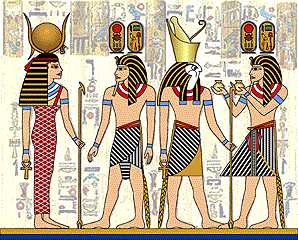
|
- The First
Intermediate Period (2181-2050BC)
The demise of the Old Kingdom brought a period of
chaos and anarchy, which characterized the
Seventh Dynasty (2181-2173BC). During this brief
period over 70 rulers were said to have laid
claim to the throne. The Eighth Dynasty
(2173-2160BC) followed the same pattern. Civil
disorders multiplied and a drought struck Egypt.
- Out of the turmoil
and Pharaonic inertia, principalities within the
realm raised up to challenge the authority of the
kings. Achthoes, ruler of Heracleopolis, seized
control of Middle Egypt, seized the throne and
founded the Ninth Dynasty (2160-2130BC).
- The kings of
Heracleopolis maintained control over northern
Egypt through the Tenth Dynasty
(2130-2040BC).
However, the rulers of Edfu and Thebes fought
over control of Upper Egypt. Thebes won the
battle over Upper Egypt and its ruler Inyotef
Sehertowy founded the Eleventh Dynasty
(2133-1991BC) with the aim of extending his power
over all the land.
|
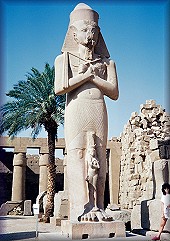
|
-
- The Middle
Kingdom (2050-1786BC)
Mentuhope II reigned over Egypt for fifty years
and re-established political and social order,
which in turn revived the economic and artistic
development that characterized the glory of the
Pharaohs. Trading was resumed and mines were
reopened. Expansionist campaigns were re-launched
against Libya, Nubia and the Bedouins of the
Sinai.
- His successors
Mentuhope III and Mentuhope IV continued to rule
from Thebes, maintaining the strength of the
Eleventh Dynasty, building and expanding their
kingdom until Amenemhat, a minister during the
Eleventh Dynasty, assumed the throne and founded
the Twelfth Dynasty (1991-1786BC).
- Amenemhat moved his
capital from Thebes back to Memphis. From here he
annexed Nubia and extended his kingdom to the
land of Sham, as far as Syria and Palestine. Al
Fayoum became the capital of the Middle Kingdom
during the reign of Amenemhat's son Senusert I.
His successors Amenemhat II and Senusert III
built the last pyramids in Lahun, Lisht and
Hawara.
|
- The Second
Intermediate Period (1786-1567BC)
The Thirteenth and Fourteenth Dynasties were
powerless to put down the Hyskos, tribal warlords
with foreign support who seized control of the
Delta, establishing the capital of Avaris and
moving south. Despite their alien origins (Hyskos
means "Princes of Foreign Lands") and
foreign ties, the Hyskos assumed an Egyptian
identity and ruled as pharaohs.
- The Hyskos dominion
was shaken by Thebes, which established the
Seventeenth Dynasty and, under Wadikheperre
Kamose, laid siege to Avaris. When his successor
Ahmosis expelled the Hyskos from Egypt in 1567BC,
the New Kingdom was born.
|
- The New
Kingdom (1567-1085BC)
Ahmosis founded the Eighteenth Dynasty
(1567-1320BC), which reigned over the first part
of a prosperous and stable imperial period during
which Pharaonic culture flowered and Egypt became
a world power.
- During the Eighteenth
Dynasty Nubia was subdued and its wealth of gold,
ivory, gemstones and ebony flowed into Egypt.
Pharaonic armies conquered the Near East, Syria
and Palestine and workers from these
new-established colonies, and a cultural
cross-fertilization took place as artisans and
intellectuals transplanted their knowledge,
skills and culture onto Egyptian soil.
- The temple of Karnak
at Thebes grew with the expansion of empire.
Tuthmosis I constructed the first tomb in the
Valley of the Kings. His daughter reigned as
pharaoh and built the temple of Deir Al-Bahri.
Tuthmosis III expanded the empire beyond Nubia
and across the Euphrates to the boundaries of the
Hittites.
|
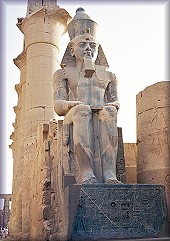
|
- The
Nineteenth Dynasty (1320-1200BC)
Was established by the Horemheb's wazir, or
minister, Ramses I who reigned for two years.
Ramses and his descendants were warrior kings who
recaptured territories lost under Akhenaten. His
successor Seti I regained controls over Egypt's
eastern colonies in Palestine, Nubia and the Near
East. Seti I also began construction on a
majestic temple at Abydos, which was completed by
his son Ramses II who reconquered Asia Minor.
- Ramses also
constructed monumental structures like the
Ramesseum in Thebes and the sun temples of Abu
Simbel. His son Merneptah spent much of his reign
driving back invaders from Libya and the
Mediterranean but he is believed to be the
biblical Pharaoh described in Exodus. Seti II was
the last king of the Nineteenth Dynasty.
- The Twentieth Dynasty
(1200-1085BC) was to be the last of the New
Kingdom and was first established by Sethnakhte.
By the reign of his successor Ramses III, the
kingdom was occupied with defending itself
against Libyan and "Sea People"
invasions. Ramses III constructed the enormous
palace temple of Medinet Hebu but the empire had
begun to disintegrate with strikes, assassination
attempts and provincial unrest.
- His successors, who
were all named Ramses, presided over the decline
of their empire until Ramses XI withdrew from
active control over his kingdom, delegating
authority over Upper Egypt to his high priest of
Amun, Herihor, and of Lower Egypt to his minister
Smendes. These two rulers were the last of the
New Kingdom.
|
- The Late
Period (1085-322BC)
The Twenty-First Dynasty was established by
successors of Herihor and Smendes who continued
to rule Upper and Lower Egypt separately from
Thebes and Tanis. But by this period external
threats from Libyan invaders and others were
eroding Egypt's power to defend itself.
Eventually both Upper and Lower Egypt succumbed
to foreign invasions. Libyan warriors who
established their own Twenty-Second Dynasty drove
the Tanites from power.
- Upper Egypt held out
longer against Nubian invaders until being
overrun by the armies of their ruler Piankhi all
the way to Memphis. Piankhi's brother Shabaka
marched north to conquer the Delta and reunite
Upper and Lower Egypt under the Twenty-Fifth
Dynasty of Nubian Kings (747-656BC). During this
period there was an artistic and cultural
revival. The Twenty-Fifth Dynasty ended when
Assyrian armies captured Memphis and attacked
Thebes, driving the Nubian pharaoh Tanutamun back
to Nubia.
- The Assyrians found a
willing Egyptian collaborator in the form of a
prince from the Delta. Psammetichus I governed on
behalf of the Assyrians until they were forced to
withdraw their forces to wage war against the
Persian Empire. On the departure of the
Assyrians, Psammetichus I declared himself
pharaoh and established the Twenty-Sixth Dynasty,
ruling over a re-united Egypt from his capital at
Sais in the Delta. This was to be the last great
Pharaonic age, which witnessed the revival of
majestic art and architecture and the
introduction of new technologies.
- Gradually, though,
the power of the kingdom was eroded through
invasion, ending ignominiously when Amasis,
"the Drunkard", was forced to depend on
Greek forces to defend his Kingdom against the
onslaught of Persian imperial armies.
- The Persians first
invaded Egypt in 525BC, initiating a period of
foreign domination of the country, which lasted
until 1952, when an Egyptian republic replaced
the monarchy of King Farouk. The conquering
Persians established the Twenty-Seventh Dynasty
(525-404BC), which ruled Egypt with an iron hand.
|
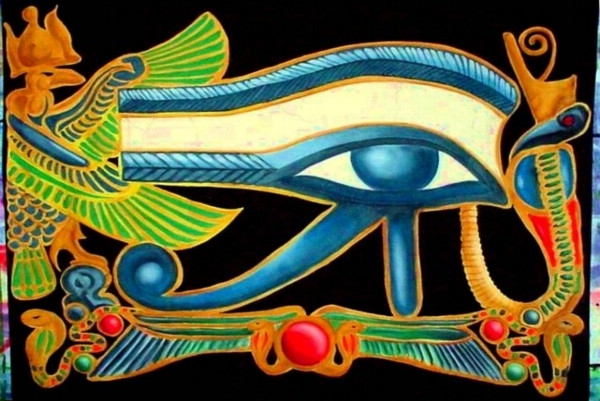
|
- Greek Rule
(332-30BC)
After centuries of upheaval and foreign
incursions, Egypt was in disarray when Alexander
established his own Pharaonic rule, reorganizing
the country's government, founding a new capital
city of Alexandria and validating the religion of
the pharaohs.
- Upon his death in
323BC, the empire of Alexandria was divided among
his Macedonian generals. Ptolemy I thus
established the Ptolemaic Dynasty, which ruled
Egypt for three centuries. Under the Ptolemys
Greek became the official language of Egypt and
Hellenistic culture and ideas were introduced and
synthesized with indigenous Egyptian theology,
art, architecture and technology. The Ptolemy's
synthesis of religious ideas resulted in the
construction of the temples of Edfu and Kom Ombo,
among other sacred structures. Alexandria became
a great capital, housing one of history's
greatest libraries.
- Gradually Ptolemaic
rule was subverted by internal power struggles
and foreign intervention. The Romans made inroads
into Ptolemaic Egypt, supporting various rulers
and factions until attaining total control over
the country when Julius Caesar's armies attacked
Alexandria.
- Queen Cleopatra VII
was the last of the Ptolemaic rulers who reigned
under the protection of the Caesar with whom she
had a son. With the assassination of Caesar, Mark
Antony arrived in Egypt and fell in love with
Cleopatra, living with her for 10 years and
helping Egypt retain its independence. The fleets
of Octavian Caesar destroyed the Egyptian navy in
the battle of Actium, driving Antony and
Cleopatra to suicide and Egypt became a province
of the Roman Empire.
|
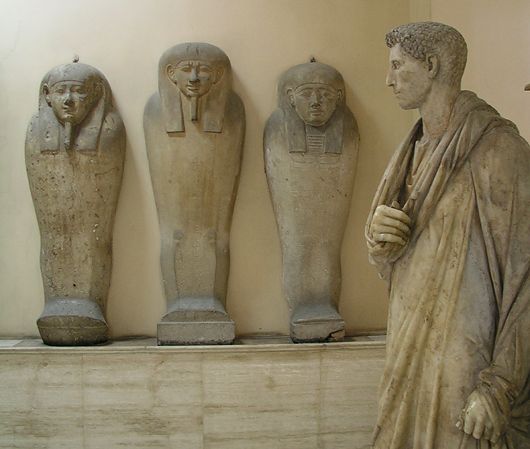
|
- Roman and
Byzantine Rule (30BC-AD638)
Octavian Caesar became the first Roman ruler of
Egypt, reigning as the Emperor Augustus. Egypt
became the granary of the Roman Empire and
remained stable for about 30 years. The Romans,
like their Greek predecessors, synthesized many
Egyptian beliefs with their own, building temples
at Dendara and Esna and Tranjan's kiosk at
Philae. Hellenism remained a dominant cultural
force and Alexandria continued to be a centre of
Greek learning.
- The Christian era
began in Egypt with the spectacular biblical
Flight of the Holy Family from Palestine. To this
day shrines and churches mark the stages of the
journey of Mary, Joseph and their infant Jesus.
According to Coptic tradition, it was not until
the arrival of Saint Mark that Christianity was
established in Egypt during the reign of Nero.
Saint Mark began preaching the gospel in about
AD40 and established the Patriarchate of
Alexandria in AD61.
- The Egyptian Coptic
Church expanded over three centuries in spite of
Roman persecution of Christian converts
throughout the Empire. In AD202 the Roman
authorities, continuing for nearly a century,
initiated persecutions against Copts. In AD284,
during the reign of the Emperor Diocletian, a
bloody massacre of Coptic
Christians took place from which the church has
dated its calendar. Christianity was legalized
and adopted as the official religion of the Roman
Empire by the Emperor Constantine.
- By the 3rd century AD
the Roman Empire was in decline as a result of
internal strife, famine and war, finally
splitting into eastern and western empires. The
Eastern Empire based in Constantinople became
known as the Byzantine Empire. The Western Empire
remained centered in Rome. The legalization of
Christianity did not stop Roman persecution of
the Coptic Christians because the Byzantine
church was based upon fundamentally different
beliefs than those of the Coptic Christian church
which had adopted a Monophysite belief in the
total divinity of Christ, as opposed to the
Byzantine belief that Christ was both human and
divine. The schism between the Byzantine and
Coptic churches was never closed.
- The Copts were
formally excommunicated from the Orthodox Church
at the Council of Chalcedon in AD451 and
established their own Patriarchate at Alexandria.
The fifth century was also a time when
monasticism emerged and the Coptic monasteries of
Saint Catherine, Saint Paul and Saint Anthony
were established as well as those at Wadi Natrun
and Sohaag.
|
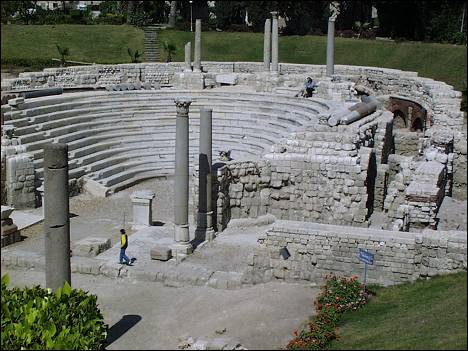
|
- The Early
Islamic Period (640-969)
Under the first Khalif of Islam Abu Bakr
As-Siddiq, the Prophet Muhammad's closest
companion, the Muslim armies vanquished the
Byzantines in AD636. They advanced toward Egypt
under the command of Amr Ibn Al-As, one of the
companions of the Prophet. The Muslims laid siege
to Babylon-in-Egypt, which surrendered. They then
took Heliopolis and in AD642 the Byzantine
imperial capital of Alexandria. Amr Ibn Al-As
established Fustat north of Babylon-in-Egypt as
his military headquarters and seat of government.
- Egypt became part of
an expanding empire that was soon to stretch from
Spain to Central Asia. The Umayyad Dynasty ruled
Egypt from Damascus until the Abbassids took
control of the Khalifate and shifted the
political capital of Islam to Baghdad.
- Ahmad Ibn Tulun who
had been sent by the Abbassid Khalif Al-Mu'taz to
govern Egypt in AD868, declared Egypt an
independent state and successfully defended his
new domain against the Abbassid armies sent to
unseat him. His dynasty ruled Egypt for 37 years.
Ibn Tulun built Al-Qitai, a new capital centered
on a vast central mosque, the courtyard of which
could accommodate his entire army and their
horses. But Tulunid rule was quickly ended by the
Abbassids, who retained direct control over Egypt
until Mohammed Ibn Tughj was appointed governor
over the province and granted the title Ikhshid,
allowing him to rule independently of khalifa's
controls.
- The Ikhshidid Dynasty
ruled from AD935-969 when Shi’a Fatimia
armies from Tunisia invaded Egypt.
|
- The
Fatimia Period (969-1171)
The Fatimid Dynasty traced their lineage from the
Prophet's daughter Fatima Zahra and her husband
Ali Ibn Abu Talib. They embraced Shi'a doctrines
which rejected the legitimacy of the first three
Khalifs of Islam, Abu Bakr, Omar and Othman, who
they claimed to be usurpers of Ali's right to
succeed the Prophet in leading Islam.
- At first the Shi'a,
or Partisans of Ali, were loyal members of the
Muslim umma who simply disagreed with the
political decision to bypass Ali. However Umayyad
machinations which lead to the assassination and
martyrdom of Ali and his sons Hassan and Hussein,
hardened Shi'a attitudes and led to a religious
schism with metaphysical
overtones, which has persisted to this day.
- The Fatimids had
separated themselves from the Sunni Khalifate and
set up their own western khalifate, which, with
their conquest of Egypt in AD969 extended across
North Africa. The Fatimids established their
imperial capital within the walls of a newly
built imperial city called Al Qahira (Cairo),
meaning "The Triumphant". Within the
walls of the city were lavish palaces and the
Mosque of Al Azhar and its University, which is
now the world's oldest existing institution of
learning.
|

|
- Ayoubid
Rule (1171-1250)
Salah al-Din Al-Ayyubi ("Saladin")
assumed control of Egypt upon the death of the
last Fatimid Khalif in 1171.
- When the Crusaders
attacked Egypt, burning part of Cairo, Salah
al-Din fortified the city and built the Citadel.
His reign was a golden age for Egypt and Salah
al-Din is revered as one of the greatest heroes
of Islam, for his humility, personal courage,
brilliant military and administrative mind and
for defeating the invading armies and treating
the vanquished with dignity.
|
- The
Mamluke Period (1250-1517)
Baybars, one of the great Ayyubid commanders,
seized power in the aftermath of Shagarat
Ad-Durr's murder but his heirs were murdered by
Qalawun, another Mamluke who established the
Bahri Mamluke dynasty, named after the Mamluke
garrison along the Nile River (Bahr Al-Nil).
During his reign Sultan Qalawun became a great
patron of architecture and constructed mosques,
fortresses and other buildings in Cairo. Qalawun
also established relations many foreign countries
in Europe, Africa and
Asia.
- Qalawun's son and
successor, Mohammed An-Nasir who reigned for
nearly half a century, from 1294-1340, was also a
great patron of architecture.
|
- Ottoman
Rule (1517-1798)
Although the Ottoman Turks were brilliant
military strategists and developed a rich Islamic
civilization, they were poor colonial
administrators. They ruled Egypt from Istanbul
through Pashawat who were trained in Istanbul.
Their direct involvement in government rarely
extended to more than enforcing tax collection.
- Otherwise the
Ottomans exercised minimal control over their new
province and relied on the Mamluke army whose
ranks continued to expand with mercenary slaves
brought in from the Caucasus.
- This lack of concern
manifested in neglect and deterioration, which
opened the way for the French invasion of Egypt
in 1798.
|

|
- European
conquest (1798-1802)
The armies of Napoleon crushed the Mamlukes at
Imbaba and occupied Cairo. Napoleon's aim was to
block British trade routes to India and to
establish a Franco phonic society in Egypt. He
imposed a French administrative system and
implemented public works projects to clean up and
renovate the long-neglected country, clearing
blocked canals, cleaning the streets and building
bridges.
|
- The
Dynasty of Mohammed Ali Pasha (1802-1892)
The French occupation destabilized Egypt and
their defeat and withdrawal left the country
vulnerable to an internal political struggle,
which was won by Mohammed Ali, an Albanian
lieutenant in the Ottoman army who, with Mamluke
help, drove the British (temporarily) out of
Egypt. The Ottomans elevate him to khedive or
viceroy of Egypt.
- In order to
consolidate his power, the new khedive realized
he had to eradicate Mamluki power, which he did
decisively and spectacularly. After six years as
ruler he invited 470 Mamluke soldiers to a
banquet at the Citadel. It was a trap. All were
massacred and the Mamluke threat was ended.
|
- British
Occupation (1882-1952)
Ismail's son Tewfiq Pasha reformed the Egyptian
economy and relinquished financial control to the
British who began to run the government of the
country. Egyptian nationalists, horrified at
Tewfiq's submission to the British, forced him to
appoint their leader Ahmed Orabi as Minister of
War, but the European reaction was swift and
violent. Alexandria was shelled and Ismailiyya
occupied. Orabi's army was defeated at Tel El
Kabir and the British reinstalled Tewfiq as a
puppet. Orabi was driven into exile and Mustafa
Kamil became the leader of the nationalist
movement.
- British influence
over Egypt continued to increase. The country
became an economic colony, totally dependent upon
the import of British manufactured goods and the
export of its raw cotton.
|
- The rule
of Nasser (1956-1970)
Gamal Abd-Al Nasser was a charismatic, ruthless,
and brilliant political leader who transformed
pan-Arab politics and left a troubled legacy to
Egypt and the Arab world. There is little doubt
that Nasser was a sincere Egyptian patriot who
wanted to improve the lot of his people. But he
was also a man utterly committed to the retention
of power at any cost, which quickly evolved into
a harsh, repressive socialist-style dictatorship.
Those involved in political opposition were
persecuted, driven underground, imprisoned,
tortured, exiled, or executed.
|
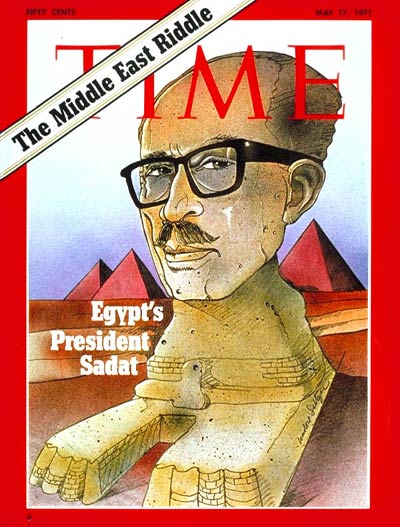 |
- The rule
of Sadat (1970-1981)
Anwar Saddat had been one of the original Free
Officers and served as Nasser's vice-president
and chosen successor, but he had never been taken
seriously until he assumed control of the
government. Saddat began to systematically
reverse the failed socialist policies of his
predecessor, ultimately expelling the Soviets and
reforming the economy. But it was Saddat's
surprise attack against Israeli forces in the
Sinai Peninsula on October 6, 1973 that gave
Sadat the credibility, which earned him the
respect of his countrymen. The October War gave
the Arab world a tremendous psychological boost.
Although the war ended in a stalemate, Sadat
emerged as a hero.
|
- The rule
of Mubarak (1981-2011)
Hosni Mubarak had been Sadat's vice-president
since 1974. At first he continued Sadat's
policies but with less flamboyance and more
domestic sensitivity. At the same time, he
accelerated the process of privatization and
developed Egypt's tourist infrastructure, which
enhanced its lucrative tourist industry.
|
The Egyptian Revolution (2011-2014)
A period characterised by popular revolt and a desire for openness and transparency. |
The rule of Al-Sisi (2014-present)
A ruler who made of building Egypt's economy a priority. |
